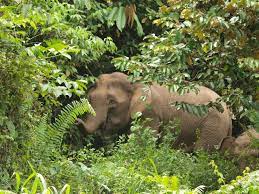One of the problems with cutting down rainforest, it often what is left is so fragmented that it is useless for conservation. Remaining blocks of forest must allow a viable population of the rarest creatures, in order for the animals not to need to travel outside protected areas.
In Borneo, like in Sumatra, there has been a rapid loss of rainforest over the last few decades. Often it is claimed that enough is left behind in order to conserve the animals that live there.

In Borneo, while there is still a large quantity of wilderness, this is increasingly fragmented.
Back in 2009, Richard Risch (a conservationist) was hiking in the northern reaches of the Tabin nature reserve, where he found elephant tracks leading up to an electric fence and then turning around and heading back. Beyond the electric fence, was endless palm oil plantations, but in an area that just recently would have been virgin rainforest.
This plot of land lies between the Tabin and Kulamber forest reserves, and should have been clear to allow wildlife to cross between the reserves.
He founded the Rhino and Forest fund, to recreate the corridor that linked these wildernesses (Kulamber forest reserve already abuts the Lower Kinabatangan-Segama wetlands), which is a ramsar site and known around the world.
This fund created a 200,000 hectare wilderness (775 square miles) which forms a corridor between these two reserves.
As soon as the fence was taken down, the elephants started moving between the reserves again. While it was believed until recently, that the Elephants of borneo were descended from a captive herd given to the Sultan of Sulu in the 17th century, recent analysis proved this wrong. Borneo elephants are distinct from other Asiatic Elephants and have not interbred with mainland elephants or Sumatran elephants for 300,000 years.
This news obviously increases the importance of protecting these elephants. The problem is that, alongside Orangutans and various other species, the Borneo Elephant needs to roam large areas to find enough food and to breed. The State of Sabah is thought to have around 1700 elephants, which means that in order to be genetically alright long-term, they need to be able to roam as widely as possible.
Fragmentation could be a death blow.
Unfortunately, these corridors are hard to make, as any land can also be used for Palm oil plantations, which makes it incredibly expensive. In Sabah there are around 1.5 million hectares of palm oil plantation, and while the state has an admirable goal of protecting 30% of its land for wildlife, if this area is fragmented, it is not going to be of much use.
By working with locals, it is believed that both locals and wildlife can flourish. There are areas which are not suitable for palm oil, such as along river banks – so by protecting land alongside rivers, corridors can be created. Furthermore, Agroforestry, which is a process of growing crops without clearing the land (many species of food we eat grow better in rainfroests) but instead planting small areas throughout a forest, can allow corridors which both wildlife and people benefit from.
As in many parts of the world, what is clear is that it is not good enough to protect only what is set aside, we also need to allow wildlife to flourish in areas which are also used by humans.
This is somethings that we recognize here. While it is in its infancy, one of our categories for looking at wild travel is “In the shadow of mankind”. If done well, local people can make more money, and so pull communities out of poverty, while at the same time allowing wildlife to survive and flourish. We hope eventually to list more in this category than in any other.
Help us spread the word.
